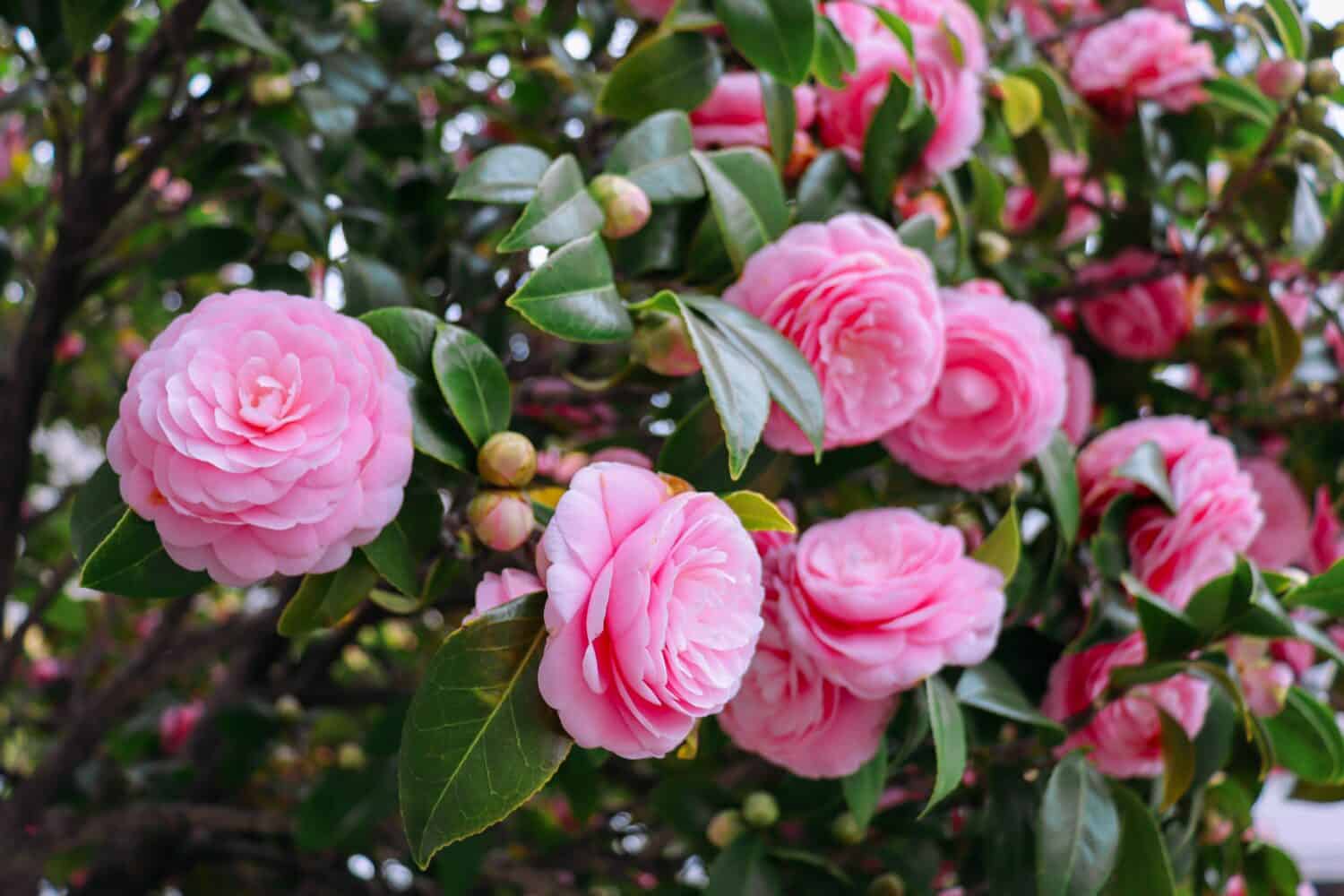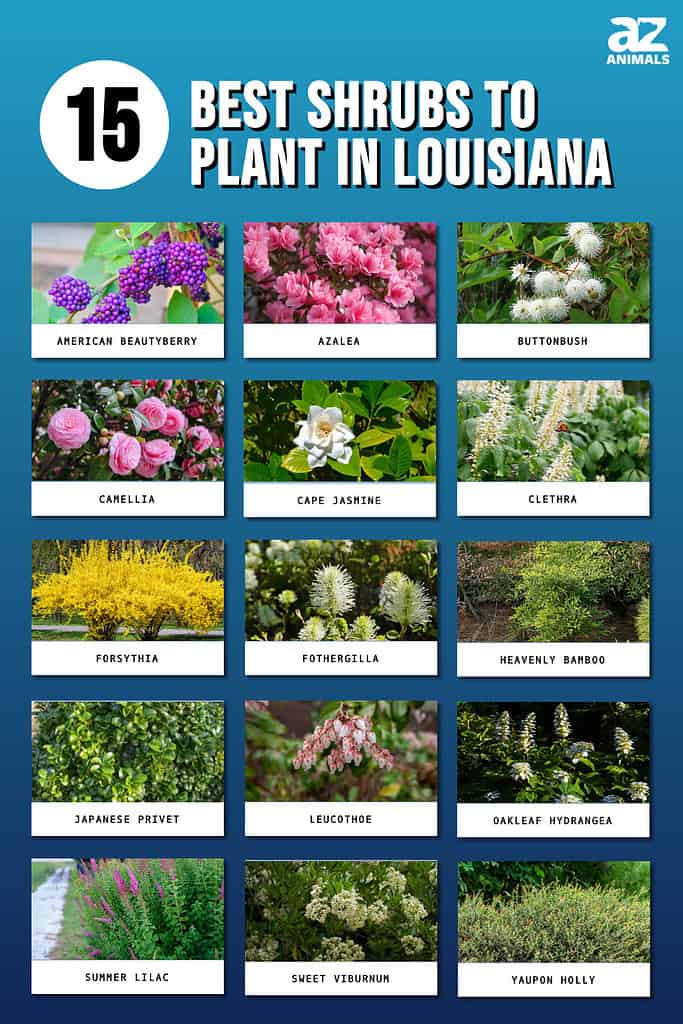
Welcome to the vibrant world of Louisiana’s lush landscapes, where nature’s beauty meets the rich local flavor of the Pelican State. Louisiana is known for its diverse climate, from the southern coast’s subtropical swamps to the north’s temperate woodlands. The landscape plants you choose play a role in enhancing your outdoor space.
Discover the 15 best shrubs to plant in Louisiana, each with its distinct charm, care requirements, and a touch of local insight.
From colorful blooms that evoke the spirit of Mardi Gras to evergreen stalwarts that withstand the heat and humidity, get ready to transform your landscape into a picturesque oasis inspired by the beauty of the Bayou State.
1. American Beautyberry (Callicarpa americana)
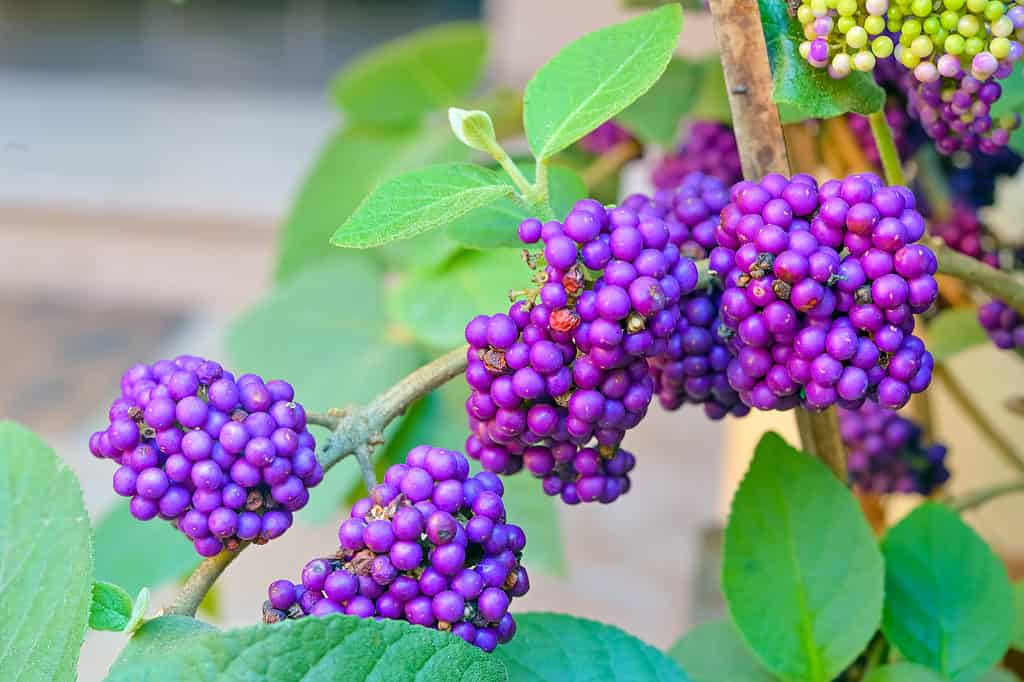
In addition to their beauty, American beautyberry’s vibrant purple berries have culinary uses, as they serve as ingredients for making jelly or wine.
©Amvi Jovas/Shutterstock.com
American beautyberry is a native deciduous shrub that graces the landscapes of Louisiana with its captivating display of vibrant purple berries. This shrub produces arching branches adorned with clusters of jewel-like berries that appear in the late summer and early fall. Beyond its ornamental appeal, the American beautyberry also serves as a valuable food source for local wildlife, particularly birds, making it a cherished addition to Louisiana gardens that celebrate both beauty and ecological significance.
The native shrub thrives in well-drained soil and can tolerate partial to full sun. Adequate watering during dry spells helps promote healthy growth and berry production. Pruning is generally minimal, mainly for shaping the shrub or removing any dead or crowded branches. With its low-maintenance nature and the ecological benefit of supporting local wildlife, the American beautyberry is a charming and practical choice for Louisiana gardeners.
Consider planting the American beautyberry as a specimen shrub or in mixed borders and naturalistic gardens. Its distinctive berries add seasonal interest and create a visual focal point.
2. Azalea (Rhododendron spp.)

People often associate azaleas with the Masters Tournament in Augusta, Georgia, where the golf course prominently features their vibrant blooms.
©PatGallery/Shutterstock.com
Azaleas are a quintessential choice for Louisiana gardens, celebrated for their vibrant and showy blooms. These deciduous shrubs belong to the Rhododendron genus and come in various species and cultivars, offering a wide array of colors and forms. In the Bayou State, gardeners commonly grow Southern Indica azaleas (Rhododendron indica), which thrive in the Creole State’s climate.
Azaleas typically bloom in the spring, filling the landscape with shades of pink, red, white, and purple, often coinciding with the lively spirit of Mardi Gras. They grow best in well-draining, acidic soils and prefer partial shade, making them ideal for planting under the canopy of larger trees or on the north side of buildings. Regular watering is essential, especially during dry spells, to keep the soil consistently moist. Mulching around the base of the shrubs helps retain moisture and regulate soil temperature. Pruning immediately after flowering can also help maintain their desired shape and encourage future blooms. Furthermore, fertilizing with an acid-rich fertilizer in the late winter or early spring will support healthy growth and prolific flowering.
In Louisiana, azaleas are a symbol of tradition and local culture. You’ll often find these stunning shrubs gracing the gardens of historic antebellum homes, accentuating the charm of plantation landscapes. Azaleas are also a cherished feature of Azalea Trail festivals, celebrated in various Louisiana cities, where residents and visitors come together to admire their beauty.
Azaleas are versatile shrubs that work well as foundation plantings, accentuating the fronts of homes with their stunning spring displays. Placing them near water features or in woodland gardens also adds a touch of natural elegance. Mass plantings of azaleas in different colors create a breathtaking visual impact, defining pathways or garden borders. These shrubs also grow well in containers on patios or balconies, providing a burst of color in smaller outdoor spaces.
3. Buttonbush (Cephalanthus occidentalis)

A favorite among wildlife enthusiasts, buttonbush’s nectar-rich flowers attract not only butterflies but also hummingbirds and bees.
©passion4nature/ via Getty Images
Native to Louisiana, buttonbush thrives in the state’s wetland areas, making it a perfect addition to landscapes with moist soil or proximity to ponds, streams, or bayous. This deciduous shrub produces distinctive spherical clusters of small, fragrant white flowers that resemble tiny buttons. These blooms attract pollinators like butterflies and bees, adding an ecological benefit to your garden.
Buttonbush is relatively low-maintenance once established. It prefers consistently moist soil and can even tolerate brief periods of standing water, making it an ideal choice for rain gardens and areas with poor drainage. Prune in the late winter to maintain a tidy shape and encourage vigorous growth in the spring. While it can tolerate partial shade, buttonbush thrives in full sun, ensuring an abundance of those unique button-like flowers.
Buttonbush’s adaptability to wetland conditions makes it a key component in supporting Louisiana’s wildlife, as it provides shelter and food for waterfowl and other aquatic creatures. Consider planting specimens near water features or in low-lying areas of your landscape where water tends to collect. It stabilizes shorelines, prevents erosion, and filters water runoff. Its unique appearance and wildlife-friendly features also make it an excellent addition to naturalistic gardens and conservation areas.
4. Camellia (Camellia japonica)
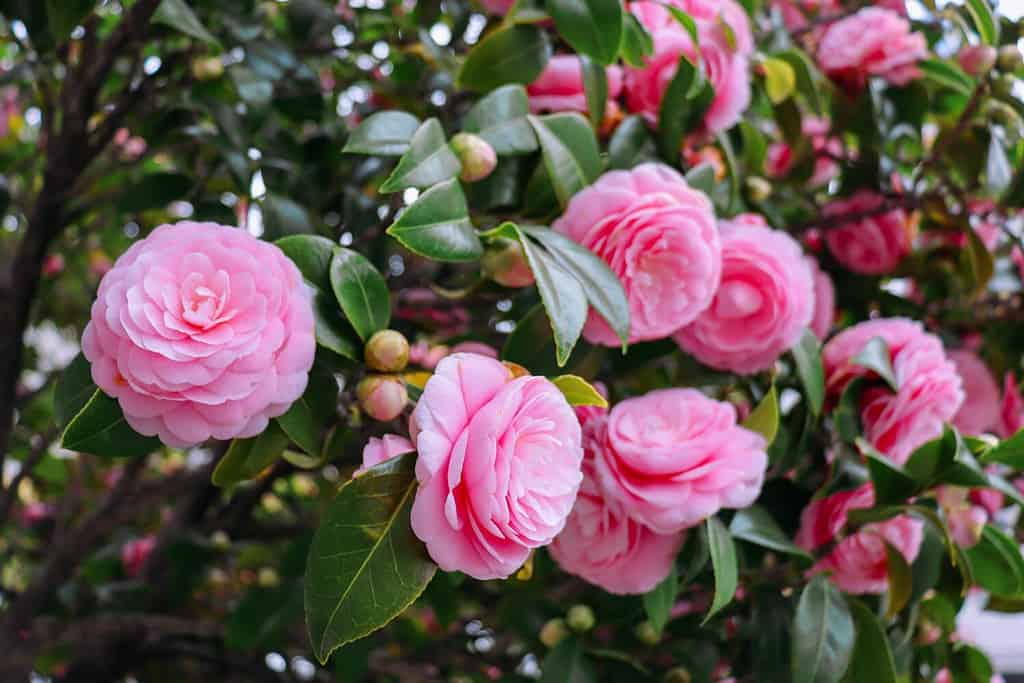
Crushed camellia leaves make tea.
©Alina_Miyazaki/Shutterstock.com
Cherished for their waxy blooms, camellias grace Louisiana gardens during the cooler months, providing a burst of color when most plants are dormant. These evergreen shrubs produce glossy, dark-green foliage and elegant, single or double-petaled flowers. In Louisiana, camellias are a symbol of Southern charm and grace.
They thrive in well-drained, acidic soils with a slightly acidic to neutral pH. They prefer partial shade, especially in the afternoon, to protect their delicate blooms from harsh sun. Adequate watering, particularly during dry spells, is essential to keep the soil consistently moist but not waterlogged. Additionally, applying a layer of mulch around the base of the shrub helps retain moisture and regulate soil temperature. You can prune camellias immediately after flowering to maintain their desired shape and encourage fresh growth.
Camellias have a rich history in Louisiana, often associated with antebellum plantations and historic Southern gardens. They are a favorite choice for corsages during Mardi Gras balls, adding a touch of elegance to the festive celebrations. Camellia shows and festivals, like the New Orleans Camellia Club’s annual exhibit, are a testament to the cultural significance of these shrubs in the Bayou State.
This evergreen shrub is versatile. Plant them as foundation shrubs to enhance the front of your home, where their winter blooms will shine. They also make beautiful accents in mixed borders or as specimen plants in woodland gardens. Camellias also grow well in containers on patios or decks, providing a touch of evergreen elegance even in small outdoor spaces.
5. Cape Jasmine (Gardenia jasminoides)
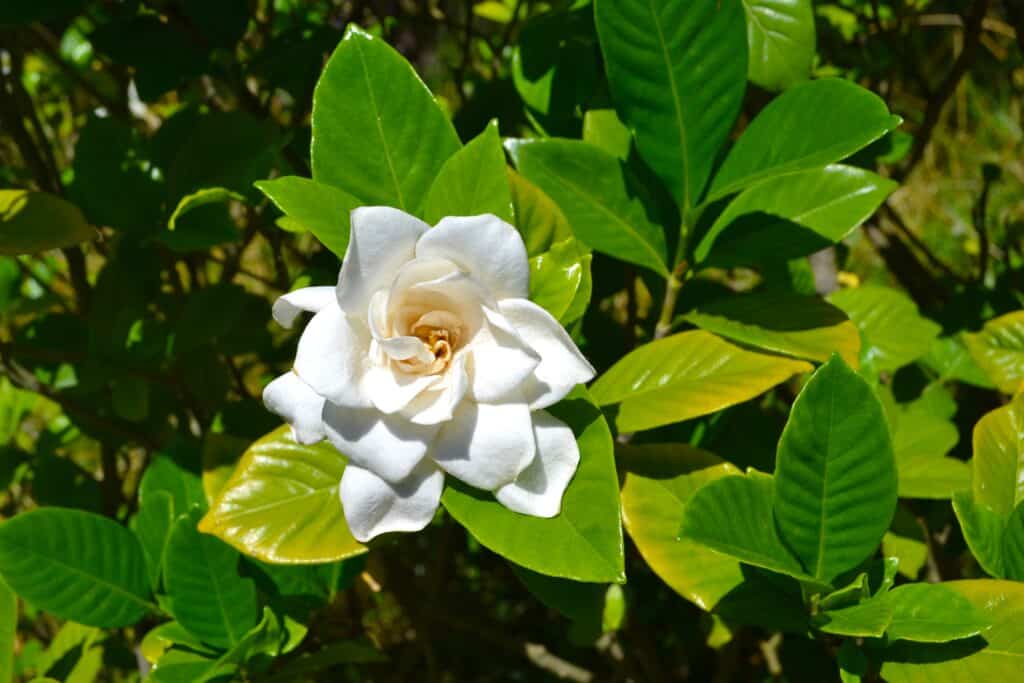
Gardenias produce a captivating fragrance, and they’re a popular choice for perfumes and scented candles.
©NADII_art/Shutterstock.com
Cape jasmine, a species of Gardenia, is a timeless and beloved evergreen shrub cherished throughout Louisiana. These fragrant beauties unfurl waxy, white, or creamy flowers that emit a sweet, intoxicating scent, filling the air with a sense of serenity. In Louisiana, gardenias thrive as both garden favorites and indoor potted plants, gracing homes and gardens with their elegance.
Furthermore, gardenias prosper in well-drained, acidic soil enriched with organic matter. They prefer partial shade, especially during the summer months when intense sunlight can scorch their delicate blooms. Consistent moisture is also important. However, gardenia do not tolerate waterlogged soil. These evergreen shrubs also benefit from occasional fertilization with a balanced, acid-rich fertilizer.
Plant cape jasmine in various landscape settings, from foundation plantings to mixed borders and even as stand-alone specimens. Their evergreen foliage ensures year-round interest, while their exquisite blooms steal the spotlight when in season. Consider planting specimens near outdoor seating areas, windows, or pathways to enjoy their fragrance.
6. Clethra (Clethra alnifolia)
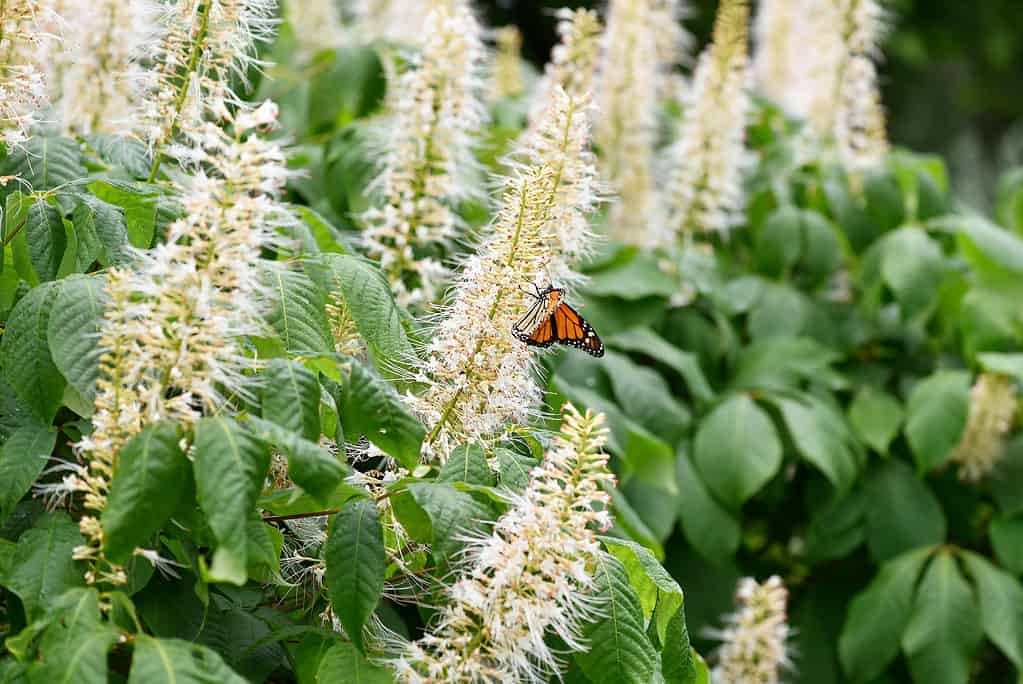
The name “sweet pepperbush” is due to clethra’s spicy, sweet fragrance.
©Lana B/Shutterstock.com
Clethra is a charming deciduous shrub that thrives in the lush landscapes of Louisiana. Also known as summersweet or sweet pepperbush, this native shrub produces spiky clusters of fragrant, white to pink blossoms that emerge in the late summer. Beyond its aesthetic appeal, clethra also plays a crucial role in supporting local pollinators, making it a valuable addition to your garden.
Specimens thrive in well-drained soils that retain moisture, making it a fantastic choice for gardens with consistently damp conditions. This shrub prefers partial shade but can tolerate full sun, especially in the morning. Adequate watering is essential, particularly during dry spells, to keep the soil consistently moist. Prune shrubs in the late winter or early spring to maintain a tidy shape.
Clethra’s late summer blooms coincide with the sweltering Louisiana heat, providing a welcome burst of color and fragrance to the garden just when many other plants are starting to fade. Consider planting specimens in areas with moist soil, such as near the edge of ponds, streams, or rain gardens. Its attractive blooms and fragrance make it an excellent choice for mixed borders and naturalistic garden designs. Additionally, clethra’s adaptability to damp conditions can help stabilize soil and prevent erosion, making it a valuable addition to landscapes near water features or low-lying areas.
7. Forsythia (Forsythia spp.)
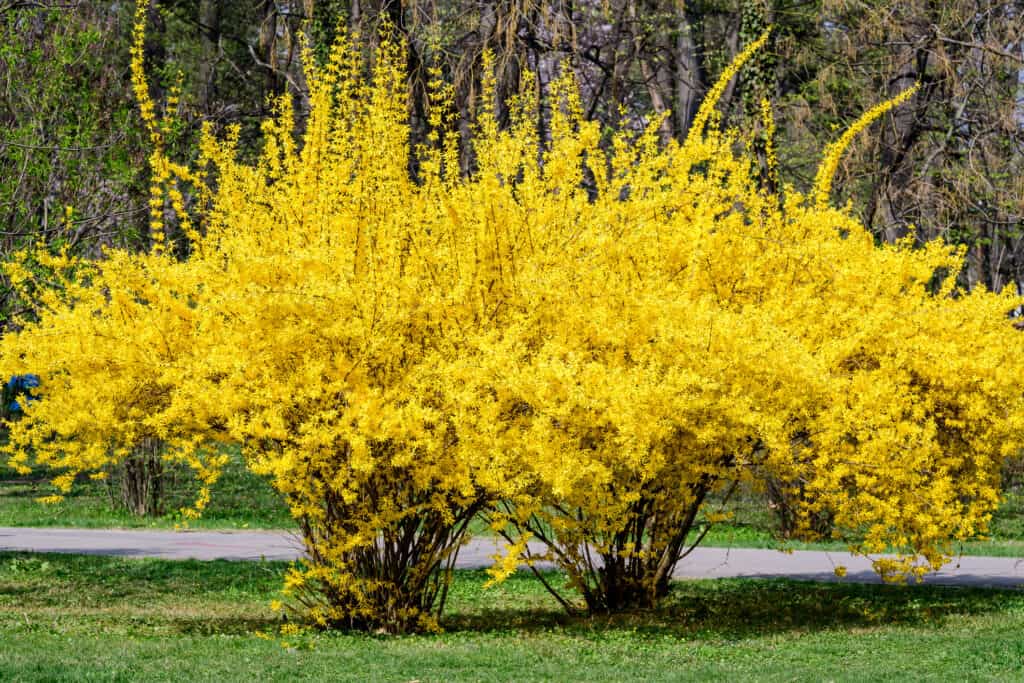
The vibrant yellow blossoms of forsythia work great in floral arrangements and add a cheerful touch to spring bouquets.
©iStock.com/Cristina Ionescu
Early-blooming forsythia is a deciduous shrub celebrated for its vibrant and cheerful display of golden-yellow blossoms. These resilient shrubs belong to the Forsythia genus, and gardeners everywhere love them for their ability to brighten up Louisiana gardens as winter transitions into the warmer months. As one of the first shrubs to burst into bloom, forsythia’s vibrant yellow flowers are a joyful sight, often appearing before the leaves emerge. In Louisiana, where the climate welcomes an early spring, forsythia is a cherished sign that the season of renewal has arrived.
It grows best in full sun and well-drained soil, making it ideal for sunlit corners of your garden. These shrubs are relatively low-maintenance, requiring minimal pruning. However, you can prune them after flowering to maintain their desired shape and encourage fresh growth. Forsythia’s adaptability and resilience make it a reliable choice for Louisiana gardeners seeking an infusion of color after the winter months.
Plant forsythia in various landscape settings, from foundation plantings to mixed borders and hedges. Its early bloom makes it an ideal candidate for providing a burst of color in gardens that have been dormant during the winter. Whether used as a stand-alone specimen or as part of a larger planting scheme, forsythia’s radiant yellow blossoms infuse your Louisiana garden with the spirit of spring, welcoming a new season of growth and beauty.
8. Fothergilla (Fothergilla spp.)

The unique name of this plant comes from Dr. John Fothergill, an 18th-century British physician and plant collector.
©EQRoy/Shutterstock.com
Fothergilla, a genus of deciduous shrubs encompassing several species, brings unique charm to Louisiana’s gardens with its captivating foliage and striking spring blooms. These native shrubs produce vibrant, bottlebrush-like spikes of white, fragrant flowers that emerge in early spring before the leaves unfurl. Fothergilla also produces awesome fall foliage, showcasing brilliant shades of red, orange, and yellow as autumn sets in.
The shrubs thrive in well-draining, acidic soils and prefer partial to full sun. Adequate moisture is crucial, especially during the establishment phase, to ensure the shrub’s health and vitality. Mulching around the base helps retain moisture and keeps the soil cool. Pruning is generally minimal, primarily for shaping and the removal of any dead or damaged branches.
Fothergilla’s unique characteristics make it a versatile addition to Louisiana landscapes. Plant it as a specimen shrub in mixed borders to showcase its striking seasonal changes. Its compact size also makes it suitable for foundation plantings or as an accent in naturalistic gardens.
9. Heavenly Bamboo (Nandina domestica)
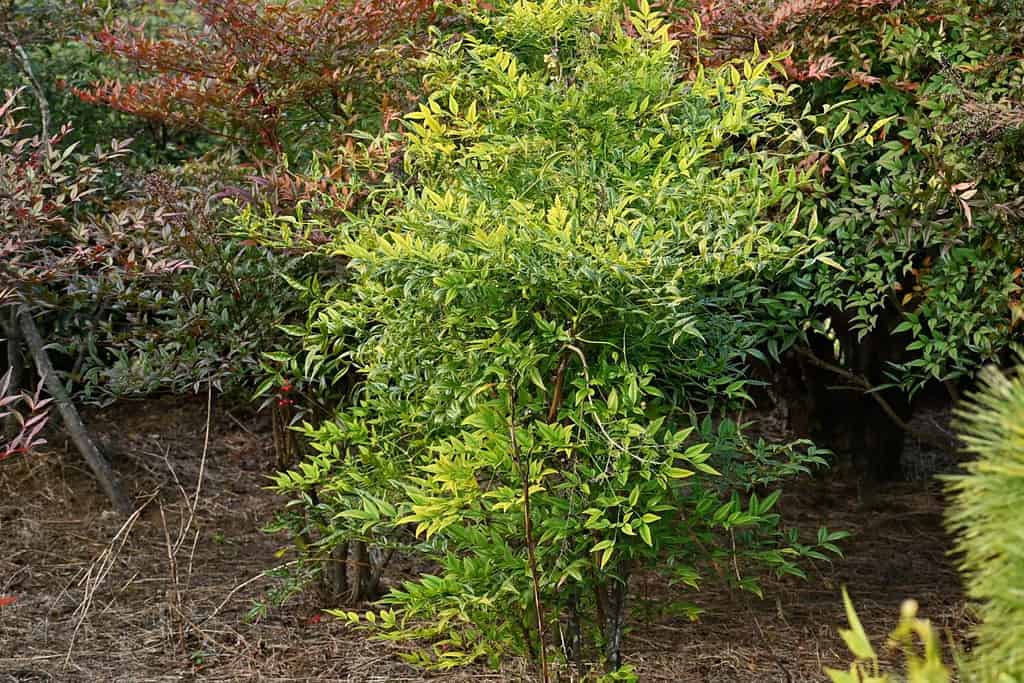
Despite its name, heavenly bamboo is not related to bamboo but rather belongs to the Barberry family.
©tamu1500/Shutterstock.com
Another versatile evergreen shrub, heavenly bamboo flourishes in the Pelican State. Despite its name, it is not a true bamboo but does produce slender, bamboo-like canes and lacy, finely-textured foliage. In addition to its graceful appearance, heavenly bamboo also showcases clusters of small, white flowers in the spring and vibrant, long-lasting berries in the autumn, adding year-round visual interest to gardens throughout the Bayou State.
This low-maintenance shrub thrives in well-drained soil and can tolerate various light conditions, from full sun to partial shade. Once established, it is relatively drought-tolerant, making it suitable for Louisiana’s climate. Prune specimens in the late winter or early spring to shape the plant and remove any dead or crowded growth. Additionally, heavenly bamboo’s brilliant red berries are a valuable food source for birds, contributing to the local ecosystem.
Plant this versatile shrub as a foundation shrub, where its evergreen foliage provides year-round structure and interest. Heavenly bamboo is also an excellent choice for mass plantings, borders, and even containers. Its unique appearance and low maintenance requirements make it a valuable addition to both residential and public gardens, enhancing the allure of Louisiana’s landscapes throughout the seasons.
10. Japanese Privet (Ligustrum japonicum)

Because of its ability to spread rapidly and crowd out native plants, Japanese privet is considered invasive in some areas.
©Peter Turner Photography/Shutterstock.com
Japanese Privet is another popular evergreen shrub in Louisiana gardens. This hardy shrub yields dense, glossy foliage and is adaptable to various growing conditions. In the late spring to early summer, Japanese privet produces small, fragrant white flowers that attract pollinators, followed by clusters of dark berries in the fall. Its resilience and low-maintenance nature make it a valued addition to landscapes throughout the state.
Japanese privet thrives in full sun to partial shade and adapts to a wide range of soil types. Regular watering during the establishment phase helps promote healthy growth, but once established, it can tolerate periods of drought. Japanese privet grows rapidly, making it a reliable choice for creating hedgerows and privacy screens.
Whether used as a hedge, screen, or foundation planting, Japanese privet’s adaptability and low maintenance requirements make it a sought-after choice for Louisiana gardeners seeking both form and function. Its dense growth habit is particularly valuable for creating privacy or separating different areas of the garden.
11. Leucothoe (Leucothoe spp.)
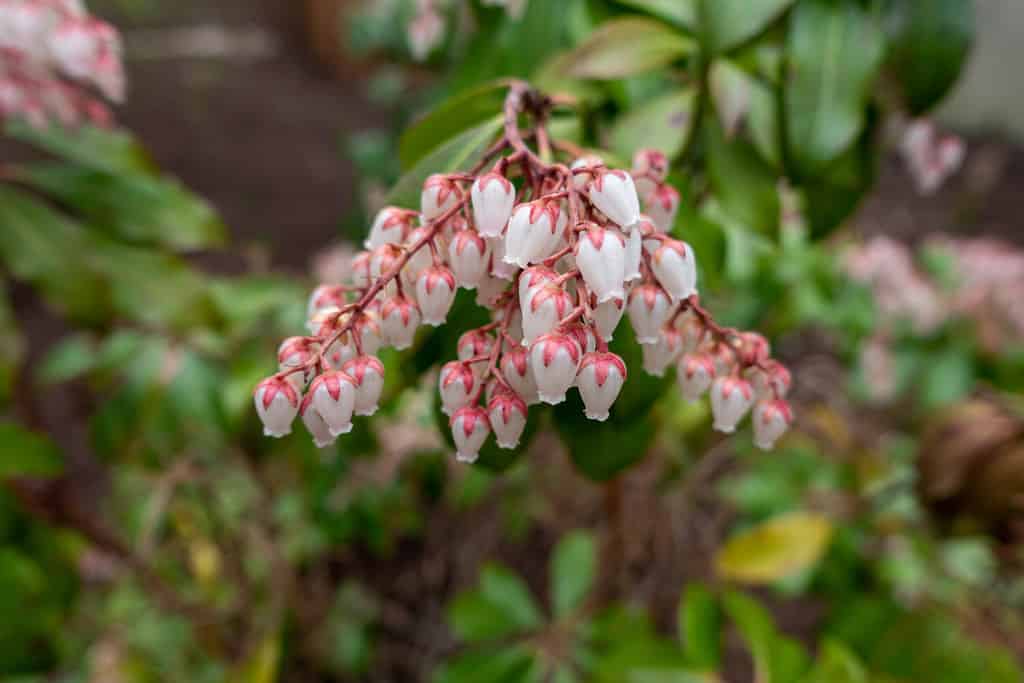
The genus name “
Leucothoe” comes from Greek mythology and refers to a sea nymph who was transformed into a plant.
©Anna Multanen/Shutterstock.com
Leucothoe, another genus of evergreen shrubs, thrives in the diverse climates of Louisiana. These versatile shrubs produce graceful, arching branches adorned with leathery, lance-shaped leaves. In the late spring to early summer, leucothoe surprises with cascades of delicate, bell-shaped, white or pink flowers that hang in clusters, adding an element of charm to shaded gardens.
Leucothoe grows well in partial to full shade and thrives in well-drained, acidic soils. However, it prefers moisture-rich soils, especially during the establishment phase. Additionally, mulching around the base helps retain moisture and maintain soil temperatures. Pruning is typically minimal and should be done in the late winter or early spring to shape the shrub.
These shade-loving, low-maintenance shrubs are an ideal choice for gardens with limited sunlight. Use it as a border plant, foundation planting, or as a textural element in mixed borders. It can also serve as cover in shaded areas, providing a lush carpet of greenery. With its graceful arching branches and delicate blooms, Leucothoe adds an element of sophistication to Louisiana’s landscapes, particularly in shaded and woodland settings.
12. Oakleaf Hydrangea (Hydrangea quercifolia)
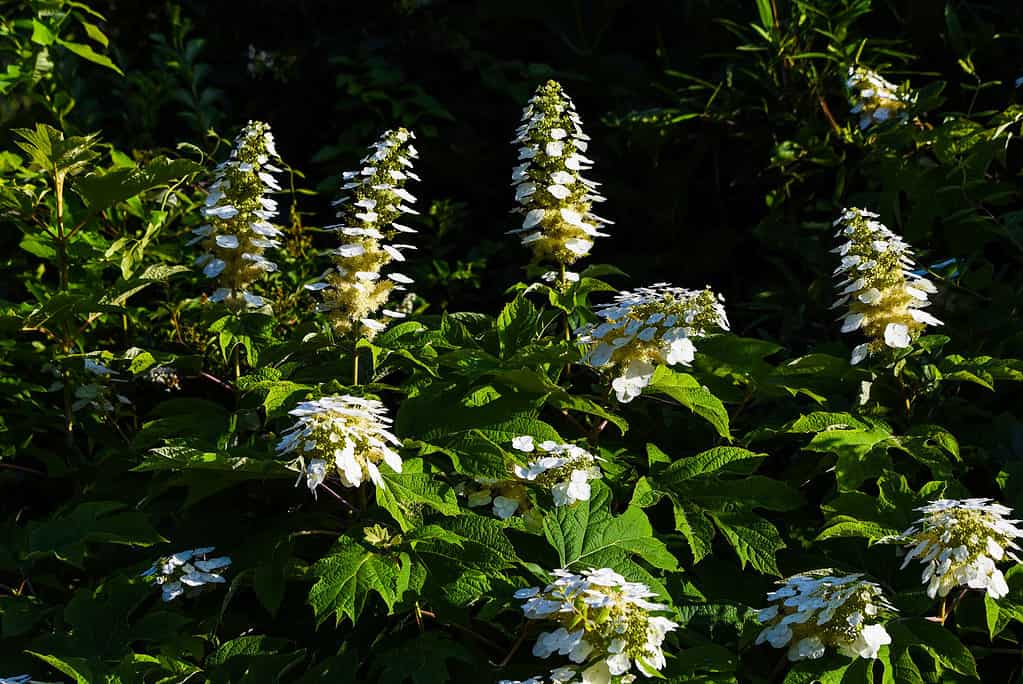
The color of hydrangea blooms can change based on the soil’s pH level; acidic soil results in blue flowers, while alkaline soil produces pink flowers.
©iStock.com/undefined undefined
Native to Louisiana, oakleaf hydrangea unfurls distinctive oak-shaped leaves and striking, cone-shaped flower clusters. This deciduous beauty is known for its impressive display throughout the seasons. In the summer, it boasts large, white, or pink panicles of blooms that transform into shades of dusky pink and brown in the fall, making it a standout in autumn gardens. Its exfoliating bark also adds winter interest, and the oak-like leaves turn brilliant shades of red and purple before dropping.
Specimens grow best in well-drained, moist soil and can tolerate a range of light conditions, from full sun to partial shade. Adequate watering during dry spells and a layer of mulch helps maintain soil moisture. Pruning is minimal and should be done in the late winter or early spring to remove dead or weak branches. Oakleaf hydrangeas are generally low-maintenance, and their distinct beauty requires little effort to maintain.
Whether used as a focal point, foundation planting, or border shrub, oakleaf hydrangeas are versatile additions to Louisiana landscapes. They can also be planted in woodland gardens or naturalistic settings, where their oak-like leaves and cone-shaped blooms complement the natural environment. With its multi-seasonal interest and adaptability, oakleaf hydrangea adds a touch of elegance and enduring beauty to the Sugar State’s gardens.
13. Summer Lilac (Buddleja davidii)
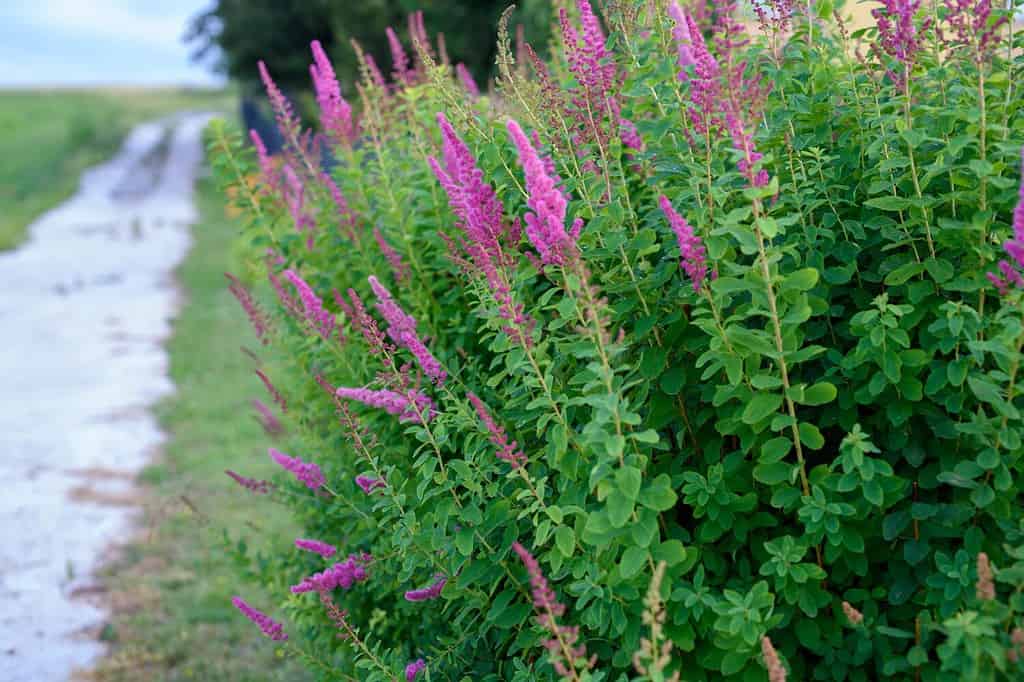
This plant is famous for its adaptability to different soil conditions and ability to thrive in urban environments.
©M9K/Shutterstock.com
Also known as butterfly bush, summer lilac is a delightful ornamental shrub that graces Louisiana gardens with its long, arching clusters of fragrant, nectar-rich flowers. This deciduous shrub is a magnet for butterflies and other pollinators, adding a lively and dynamic element to the garden. In Louisiana’s warm and sunny climate, summer lilac blooms from the late spring through early autumn, creating a colorful spectacle. Its adaptability to various soil types and its ability to attract butterflies make it a cherished addition to gardens throughout the state.
Summer lilacs need full sun and well-draining soil to thrive. It is an excellent choice for sunny spots in your garden. Additionally, regular pruning in the late winter or early spring helps maintain its shape and encourages robust flowering.
Plant summer lilac as a backdrop in mixed borders, where its long, arching flower spikes can add vertical interest. It also works well as a specimen plant or in cottage gardens, where its vibrant blooms provide a cottage garden charm. With its ability to attract butterflies and its colorful display, specimens add both vibrancy and ecological significance to the Bayou State.
14. Sweet Viburnum (Viburnum odoratissimum)
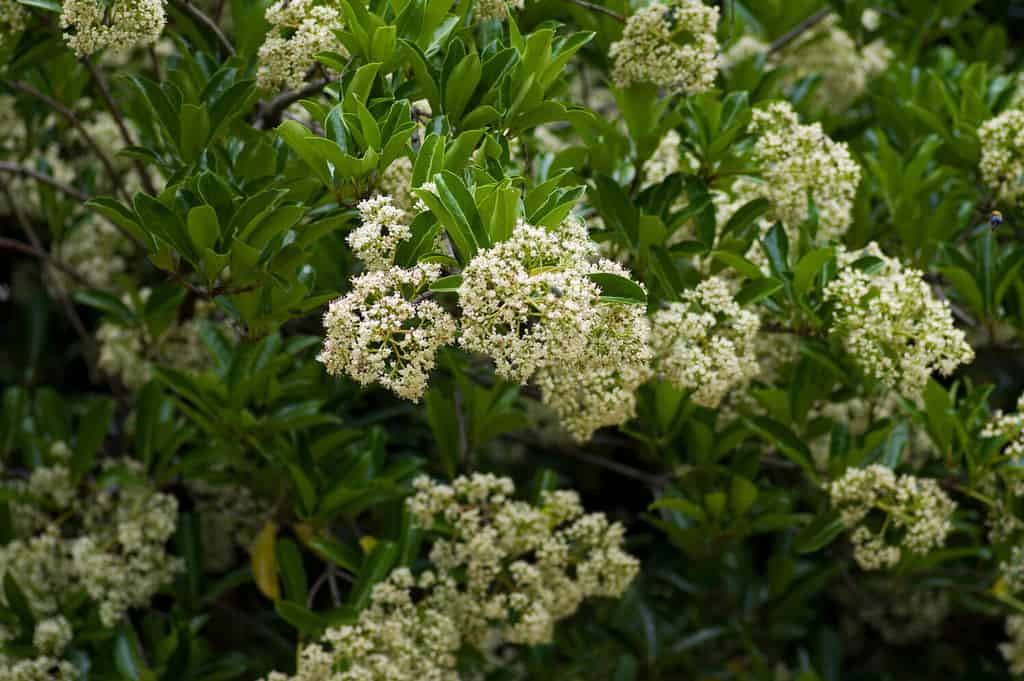
The white flowers of sweet viburnum emit a delightful fragrance that can fill the garden with a sweet and pleasant scent.
©zzz555zzz/Shutterstock.com
Sweet viburnum is a beloved evergreen shrub that flourishes in the welcoming climate of Louisiana. Known for its glossy, dark-green foliage and fragrant, snowy-white blooms, sweet viburnum adds year-round beauty to the landscape. In the spring, it produces clusters of small, sweetly scented flowers that attract pollinators, while its dense, lush foliage provides privacy and a vibrant backdrop.
Grow sweet viburnum in well-drained soil and full sun to partial shade. It appreciates regular watering during dry spells. Additionally, pruning can be done in the late winter or early spring to shape the shrub. With its robust evergreen foliage and low-maintenance nature, sweet viburnum is a reliable choice for gardeners seeking both aesthetic appeal and functionality.
Use sweet viburnum as a versatile shrub in a variety of landscape settings. It excels as a privacy screen, boundary planting, or foundation shrub. Its dense growth habit and fragrant blossoms also make it an excellent choice for hedging and defining outdoor spaces.
15. Yaupon Holly (Ilex vomitoria)
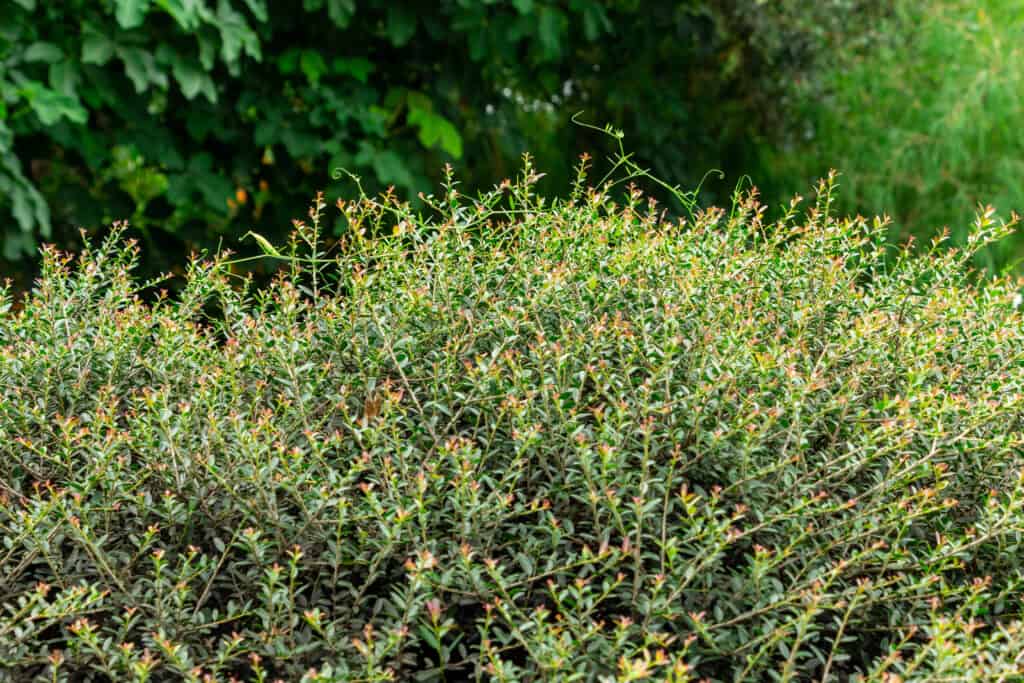
This plant has a history of use by Native Americans who brewed its leaves into a caffeinated beverage.
©Sunshower Shots/Shutterstock.com
Yaupon holly is another native evergreen shrub that thrives in the diverse landscapes of Louisiana. This versatile and adaptable shrub produces glossy, dark-green foliage. In the spring, yaupon holly produces small, inconspicuous flowers, followed by an abundance of bright red berries in the fall and winter, which not only add visual interest but also provide sustenance for local wildlife, including birds.
Yaupon holly is a hardy shrub that can thrive in full sun to partial shade. It is remarkably drought-tolerant once established, making it well-suited to Louisiana’s climate. While pruning is generally minimal, it can be done in the late winter or early spring. Furthermore, yaupon holly’s berries are non-toxic to humans and wildlife, and their presence enhances the garden’s ecological value.
Whether used as a hedge, foundation planting, or accent shrub, yaupon holly’s adaptability and low maintenance requirements make it a popular choice among Louisiana gardeners. Its dense growth habit also makes it suitable for screening and privacy purposes. With its resilience and ecological benefits, yaupon holly adds both beauty and function to the Bayou State’s landscapes, enhancing the natural beauty and sustainability of the region.
Summary: 15 Best Shrubs to Plant in Louisiana
| Number | Common Name | Mature Height |
|---|---|---|
| 1 | American Beautyberry | 3-9 feet |
| 2 | Azalea | 3-8 feet |
| 3 | Buttonbush | 6-12 feet |
| 4 | Camellia | 6-12 feet |
| 5 | Gardenia | 3-6 feet |
| 6 | Clethra | 3-8 feet |
| 7 | Forsythia | 4-6 feet |
| 8 | Fothergilla | 3-5 feet |
| 9 | Heavenly Bamboo | 4-8 feet |
| 10 | Japanese Privet | 6-12 feet |
| 11 | Leucothoe | 3-5 feet |
| 12 | Oakleaf Hydrangea | 3-6 feet |
| 13 | Summer Lilac | 6-12 feet |
| 14 | Sweet Viburnum | 6-15 feet |
| 15 | Yaupon Holly | 3-12 feet |
Thank you for reading! Have some feedback for us? Contact the AZ Animals editorial team.

